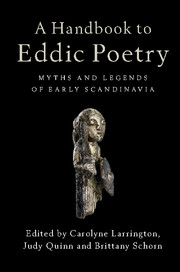Book contents
- Frontmatter
- Contents
- List of illustrations
- List of contributors
- Translations and abbreviations of the titles of eddic poems
- Introduction
- 1 The transmission and preservation of eddic poetry
- 2 Traditions of eddic scholarship
- 3 The editing of eddic poetry
- 4 The dating of eddic poetry
- 5 Eddic performance and eddic audiences
- 6 Eddic poetry and mythology
- 7 Eddic poetry and the religion of pre-Christian Scandinavia
- 8 Eddic poetry and heroic legend
- 9 Place names in eddic poetry
- 10 Eddic poetry and the imagery of stone monuments
- 11 Eddic poetry and archaeology
- 12 Eddic modes and genres
- 13 Eddic metres
- 14 Eddic style
- 15 Kennings and other forms of figurative language in eddic poetry
- 16 Alliterative lexical collocations in eddic poetry
- 17 The representation of gender in eddic poetry
- 18 The reception of eddic poetry
- Consolidated bibliography
- Index
17 - The representation of gender in eddic poetry
Published online by Cambridge University Press: 05 August 2016
- Frontmatter
- Contents
- List of illustrations
- List of contributors
- Translations and abbreviations of the titles of eddic poems
- Introduction
- 1 The transmission and preservation of eddic poetry
- 2 Traditions of eddic scholarship
- 3 The editing of eddic poetry
- 4 The dating of eddic poetry
- 5 Eddic performance and eddic audiences
- 6 Eddic poetry and mythology
- 7 Eddic poetry and the religion of pre-Christian Scandinavia
- 8 Eddic poetry and heroic legend
- 9 Place names in eddic poetry
- 10 Eddic poetry and the imagery of stone monuments
- 11 Eddic poetry and archaeology
- 12 Eddic modes and genres
- 13 Eddic metres
- 14 Eddic style
- 15 Kennings and other forms of figurative language in eddic poetry
- 16 Alliterative lexical collocations in eddic poetry
- 17 The representation of gender in eddic poetry
- 18 The reception of eddic poetry
- Consolidated bibliography
- Index
Summary
Introduction
The text of the Codex Regius begins with a seeress asking for silence so that she can recite her prophecy about gods, giants, and men; a story of creation and destruction, rise, fall, and rebirth. We learn how Óðinn and his two brothers set up Miðgarðr, the realm of the gods, and bring order to chaos, ostensibly living in civilised harmony until discord arrives in the guise of Heiðr. The vǫlva (seeress) then describes how – through escalating discord – the gods bring their own universe to destruction, causing it to be ravaged by monsters. No one survives apart from a select few individuals who people a new world, but the vǫlva disappears into the ground at the end of the poem. Vǫluspá sets the thematic tone for what is to come in the rest of the eddic corpus, where characters appear in multidimensional roles, whether positive or negative, active or passive, human or monstrous, traditional or subversive, admired or stigmatised.
In this chapter, we begin with an overview of how normative versions of masculinity and femininity are represented in eddic poetry, as well as of those characters and behaviours that fall outside these categories. More importantly, perhaps, we also examine where male and female gender roles blur or overlap, or where they are rendered ambiguous. Our readings are informed by different aspects of gender theories and the tools they offer in analysing eddic texts, as well as the work of previous Old Norse scholars, which has contributed to a better understanding of gender representations. Finally, we present several case studies of gendered images, highlighting what we consider to be some of the most important aspects of gender representations and their ideological functions. The goal of this chapter, then, is to give the reader an insight into the diverse, complex, and fascinating perspectives on gender found in eddic poetry, and to offer possible ways of interpreting them.
Defining ‘gender’
Arguably, the inclusion of gender perspectives has until recently been marginalised in Old Norse scholarship (and in eddic studies more narrowly). Nonetheless, gender constructions condition every subject's identity and limit the scope of available and forbidden roles, both for male and female figures. They are thus fundamental to understanding eddic texts and the society from which they emerge.
- Type
- Chapter
- Information
- A Handbook to Eddic PoetryMyths and Legends of Early Scandinavia, pp. 331 - 348Publisher: Cambridge University PressPrint publication year: 2016
- 3
- Cited by



